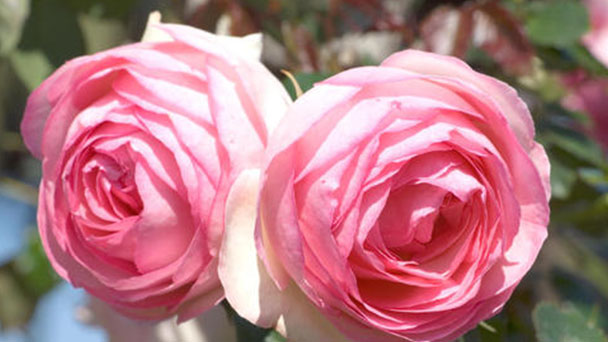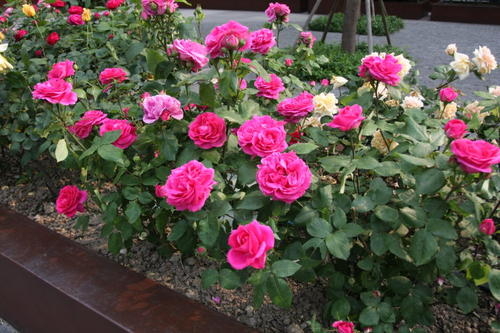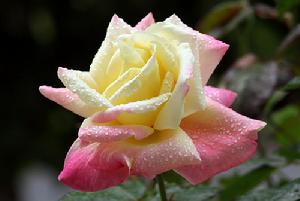French roses profile
Written by Maggie
Aug 31 2021

French roses are hardy, drought-tolerant, high disease resistant, resistant to pollution. French roses flowering period is long, the flower is big, the oil yield is high, suits the national each place climate planting, is the rare excellent variety.
French roses picture
French roses morphological characteristics
French roses are deciduous erect bushy shrubs, stems and branches grayish brown, densely bristled with barbs, pinnately compound leaves, leaflets 5-9, elliptic to elliptic obovate, obtuse serrate, thick, wrinkled, bright green above, grayish green below, pilose or spiny, petiole and leaf axles sparsely prickly and glandular hairs. Stipules of french roses are mostly connate with petiole, serrulate. Flowers of French roses are solitary or 3-6 clustered, 6-8 cm in diameter, fragrant, densely covered with fuzz and spines, purple or white petals, single or double. Rosocarp oblate, red, persistent
French roses growing environment
French Roses prefer dry soil with low tide, and need to ensure water supply during the vigorous growth stage. French roses demand for fertilizer is more, in addition to the application of base fertilizer at the time of planting, the growth stage can be every 2-3 weeks top dressing. French Roses likes full sunlight and grows well in sparse shade environments, with no less than 4 hours of daylight exposure per day, and full sunlight is preferred. French roses like warm, cold tolerance, in the temperature range of 14-- 28℃ growth is better, and can withstand a low temperature of 10℃.
The distribution of French roses
French roses are native to the East, but today they are probably found all over the world, mainly in temperate zones.
French roses propagation methods
French roses are mainly propagated by cuttings, and are carried out in spring and summer each year.In order to encourage cuttings to take root quickly and improve the survival rate of young seedlings, it is best to harvest cuttings from the branches of flowers that have just withered. First cut the French Roses branches into 10 to 12 cm long sections. Be careful to keep the scissors sharp, if the cuttings split, it will interfere with the proper rooting. Then they are placed in the fine sand bed, and can be kept two to three centimeters apart. Seedbeds of French roses should be arched scaffolding and covered with colorless plastic film for moisture. Spray water frequently to maintain air humidity and pay attention to shade. The cuttings should be transplanted when French roses have grown four to six new roots. Seedling can also be raised by seeding, dividing plants and pressing strips.

How to grow and care for French roses
Cultivation substrate
The soil requirements of French roses are not strict. If possible, it is advisable to choose loose, fertile, well-drained sandy loam.It can also grow well in V thin land.
Engraftment method
Ground planting, French Roses seedlings are usually planted in spring and summer. You should choose a high, sunny place. According to the diameter of 50 centimeters, depth of 50 centimeters of the size of the hole digging. It is best to apply barnyard manure in the hole, and pay attention to cover it with subsoil so as not to burn the roots. Usually put a biennial seedling in each hole, first righting it, so that the root system of French roses is scattered, and then fill the soil to step on. Then pour permeable once, after 3 to 5 days, still need to pour two water again. Transplanting of French roses is best performed on cloudy days.
Key points of management
Loosening the soil once a month helps the root system develop and can help the French roses grow better. Cut off the new branches after they have bloomed.In the winter plant after deciduous, but also for short cut, to remove diseased branches, cross branches, dead branches, emasculated branches; Plastic soil can be applied to the base of the French roses to protect it, so as to reduce the occurrence of stripping phenomenon.
Prevention and control of diseases and pests of French roses
In practical cultivation, French Roses will be harmed by powdery mildew and black spot, and will be invaded by harmful animals such as dragonfly, rose wasp and aphids.

Latest Updated
- Benefits of Bugleweed - 7 Science-backed Health Benefits
- Bugleweed Dangers & Side Effects - Is It Poisonous?
- How to Plant Evergreen Trees - What You Should Know
- When to Plant Evergreens - Grow Guide for Evergreen Trees
- 12 Wonderful Evergreen Shrubs for Your Garden
- 12 Popular Evergreen Plants with Pictures for Beginners
- When And How To Prune A Lilac Bush Like a Pro
- How to Grow & Care for Lilac Vine (Hardenbergia Violacea)
- Japanese Lilac Tree (Syringa Reticulata) Care & Propagation Guide
- Shumard Oak Pros and Cons - What to Know
Popular Articles
- Winter maintenance of Antirrhinum Majus
- How to Grow Terminalia Mantaly Tree
- How to Grow and Care for Crossostephium Chinense
- How to grow Antirrhinum Majus in spring
- Peristeria Elata (Dove Orchid) Profile: Info & Care Guide
- Underwatered Snake Plant (Sansevieria Trifasciata) - Signs And How To Fix
- How to Care for Brazilian Jasmine Plant (Mandevilla Sanderi)
- How to Grow & Care for Graptopetalum Purple Delight in Summer
- Rosa Chinensis (China Rose): Plant Growing & Care Tips
- How to Care for Baby Sun Rose (Aptenia Cordifolia)
